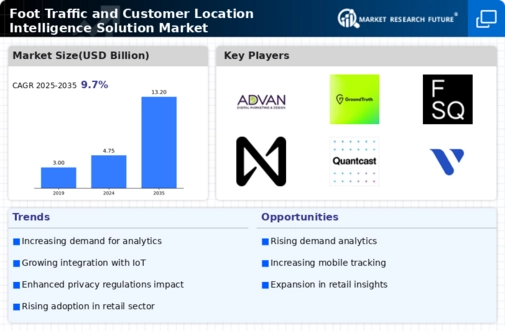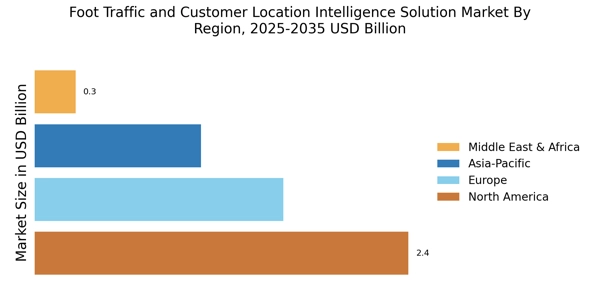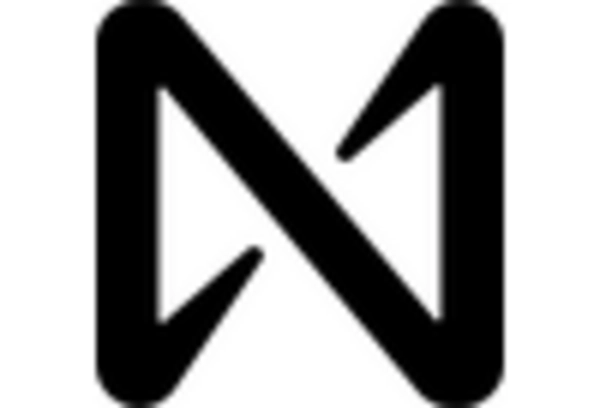Expansion of Smart City Initiatives
The expansion of smart city initiatives is significantly influencing the Foot Traffic and Customer Location Intelligence Solution Market. As urban areas evolve into smart cities, the integration of technology into infrastructure and services becomes increasingly prevalent. This transformation necessitates the collection and analysis of foot traffic data to optimize urban planning and enhance public services. For instance, city planners can utilize location intelligence to monitor pedestrian movement patterns, improving safety and accessibility. The global investment in smart city projects is projected to exceed USD 1 trillion by 2025, indicating a substantial opportunity for location intelligence solutions. As municipalities seek to create more efficient and livable environments, the demand for foot traffic and customer location intelligence solutions is likely to grow, aligning with the broader trend of urban modernization.
Increased Focus on Retail Analytics
The increased focus on retail analytics is a key driver in the Foot Traffic and Customer Location Intelligence Solution Market. Retailers are increasingly adopting analytics to gain insights into consumer behavior and optimize their operations. The ability to analyze foot traffic data allows businesses to identify trends, assess store performance, and refine marketing strategies. Market Research Future indicates that retailers utilizing location intelligence can experience a 15% increase in sales due to improved targeting and customer engagement. As competition in the retail sector intensifies, the need for actionable insights derived from foot traffic data becomes essential. Consequently, the growing emphasis on retail analytics is expected to propel the demand for customer location intelligence solutions, as businesses strive to enhance their competitive edge.
Integration of Advanced Technologies
The integration of advanced technologies is a pivotal driver in the Foot Traffic and Customer Location Intelligence Solution Market. The advent of Internet of Things (IoT) devices and sophisticated analytics platforms has transformed how businesses collect and interpret location data. For instance, the use of beacons and geofencing technologies enables retailers to gather precise foot traffic information, enhancing their ability to tailor marketing efforts. This technological evolution is reflected in the increasing investment in location intelligence solutions, which is expected to reach USD 10 billion by 2026. Furthermore, the incorporation of artificial intelligence and machine learning algorithms into these solutions allows for predictive analytics, enabling businesses to anticipate customer behavior and preferences. Consequently, the integration of these advanced technologies is likely to propel the growth of the market, as organizations strive to remain competitive in an ever-evolving landscape.
Rising Demand for Data-Driven Insights
The Foot Traffic and Customer Location Intelligence Solution Market is experiencing a notable surge in demand for data-driven insights. Businesses are increasingly recognizing the value of understanding customer behavior and preferences through location data. This trend is evidenced by a projected growth rate of approximately 20% annually, as companies seek to leverage analytics for strategic decision-making. By utilizing foot traffic data, organizations can optimize their marketing strategies, enhance customer engagement, and improve operational efficiency. The ability to analyze real-time foot traffic patterns allows businesses to make informed decisions regarding store placements, promotional activities, and inventory management. As competition intensifies, the need for actionable insights derived from customer location intelligence becomes paramount, driving the growth of this market.
Growing Emphasis on Customer Experience
In the Foot Traffic and Customer Location Intelligence Solution Market, there is a growing emphasis on enhancing customer experience. Businesses are increasingly aware that understanding customer journeys and preferences is crucial for fostering loyalty and satisfaction. By leveraging location intelligence, companies can create personalized experiences that resonate with their target audience. For example, retailers can utilize foot traffic data to identify peak shopping times and optimize staffing levels accordingly, ensuring that customers receive timely assistance. This focus on customer experience is supported by market data indicating that 86% of buyers are willing to pay more for a better customer experience. As organizations prioritize customer-centric strategies, the demand for location intelligence solutions is expected to rise, further driving the growth of the market.


















Leave a Comment